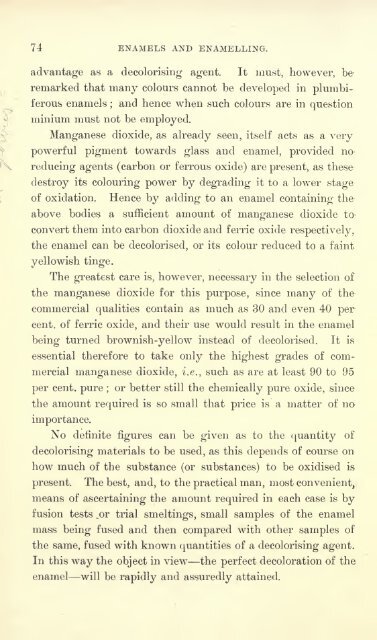Enamels and enamelling; an introduction to the preparation and ...
Enamels and enamelling; an introduction to the preparation and ...
Enamels and enamelling; an introduction to the preparation and ...
You also want an ePaper? Increase the reach of your titles
YUMPU automatically turns print PDFs into web optimized ePapers that Google loves.
74 ENAMELS AND ENAMELLING.<br />
adv<strong>an</strong>tage as a decolorising agent. It must, however, beremarked<br />
that m<strong>an</strong>y colours c<strong>an</strong>not be developed in plumbi-<br />
ferous enamels ;<br />
minium must not be employed.<br />
<strong><strong>an</strong>d</strong> hence when such colours are in question<br />
M<strong>an</strong>g<strong>an</strong>ese dioxide, as already seen, itself acts as a very<br />
powerful pigment <strong>to</strong>wards glass <strong><strong>an</strong>d</strong> enamel, provided no<br />
reducing agents (carbon or ferrous oxide) are present, as <strong>the</strong>se<br />
destroy its colouring power by degrading it <strong>to</strong> a lower stage<br />
of oxidation. Hence by adding <strong>to</strong> <strong>an</strong> enamel containing <strong>the</strong><br />
above bodies a sufficient amount of m<strong>an</strong>g<strong>an</strong>ese dioxide <strong>to</strong><br />
convert <strong>the</strong>m in<strong>to</strong> carbon dioxide <strong><strong>an</strong>d</strong> ferric oxide respectively,<br />
<strong>the</strong> enamel c<strong>an</strong> be decolorised, or its colour reduced <strong>to</strong> a faint<br />
yellowish tinge.<br />
The greatest care is, however, necessary in <strong>the</strong> selection of<br />
<strong>the</strong> m<strong>an</strong>g<strong>an</strong>ese dioxide for this purpose, since m<strong>an</strong>y of <strong>the</strong><br />
commercial qualities contain as much as 30 <strong><strong>an</strong>d</strong> even 40 per<br />
cent, of ferric oxide, <strong><strong>an</strong>d</strong> <strong>the</strong>ir use would result in <strong>the</strong> enamel<br />
being turned brownish-yellow instead of decolorised. It is<br />
essential <strong>the</strong>refore <strong>to</strong> take only <strong>the</strong> highest grades of com-<br />
mercial m<strong>an</strong>g<strong>an</strong>ese dioxide, i.e., such as are at least 90 <strong>to</strong> 95<br />
per cent, pure ;<br />
or better still <strong>the</strong> chemically pure oxide, since<br />
<strong>the</strong> amount required is so small that price is a matter of no<br />
import<strong>an</strong>ce.<br />
No definite figures c<strong>an</strong> be given as <strong>to</strong> <strong>the</strong> qu<strong>an</strong>tity of<br />
decolorising materials <strong>to</strong> be used, as this depends of course on<br />
how much of <strong>the</strong> subst<strong>an</strong>ce (or subst<strong>an</strong>ces)<br />
<strong>to</strong> be oxidised is<br />
present. The best, <strong><strong>an</strong>d</strong>, <strong>to</strong> <strong>the</strong> practical m<strong>an</strong>, most convenient,<br />
me<strong>an</strong>s of ascertaining <strong>the</strong> amount required in each case is by<br />
fusion tests kor trial smeltings, small samples of <strong>the</strong> enamel<br />
mass being fused <strong><strong>an</strong>d</strong> <strong>the</strong>n compared with o<strong>the</strong>r samples of<br />
<strong>the</strong> same, fused with known qu<strong>an</strong>tities of a decolorising agent.<br />
In this way <strong>the</strong> object in view <strong>the</strong> perfect decoloration of <strong>the</strong><br />
enamel will be rapidly <strong><strong>an</strong>d</strong> assuredly attained.
















